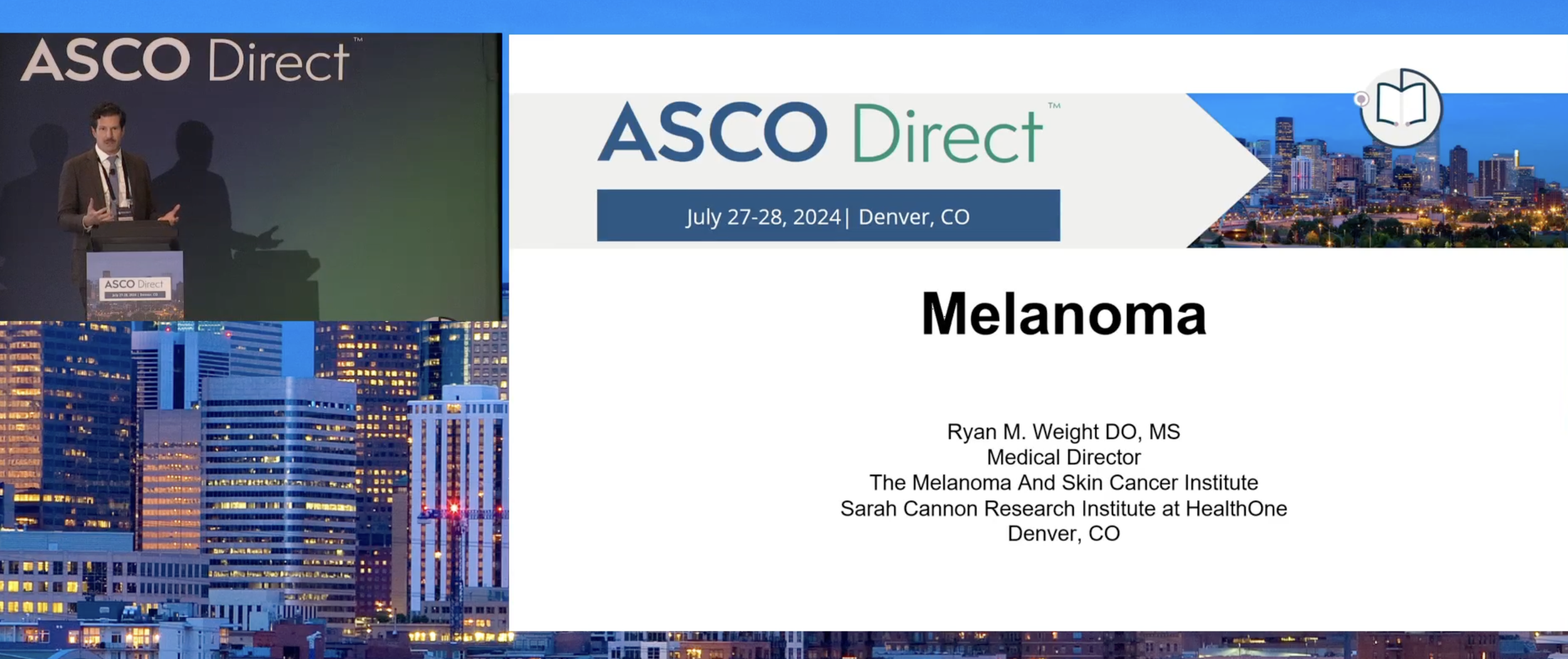ASCO Denver 2024: Dr Weight Discusses Results from NADINA in Stage III Melanoma
Presented by:
Ryan Weight, DO, MS, Medical Director, The Melanoma and Skin Cancer Institute; Sarah Cannon Research Institute at HealthOne
Meeting:
2024 ASCO Direct ™ Denver
The Bottom Line
Immunotherapy, which helps a patient’s immune system to better recognize and attack cancer cells, has become an important component of therapy for patients with melanoma that is advanced or metastatic. Whether immunotherapy is best used before or after surgery, however, is a topic of ongoing research . A new study suggests that using immunotherapy neoadjuvantly, or before surgery, is more effective than using immunotherapy adjuvantly, or after surgery, in advanced melanoma patients.
Background:
Immunotherapy using immune checkpoint inhibitors (ICI) has become an integral part of treatment for patients with advanced melanoma. Most ICIs to date have been approved when used in the adjuvant setting, once the patient’s primary tumor has been excised from the body. Previous experimental studies, however, have suggested that using ICIs neoadjuvantly (pre-surgery), while the tumor and its blood supply are still in place, causes a more intense and robust activation of the immune system against the existing tumor, that can better target and destroy tumor cells. The NADINA trial was the first phase 3 controlled study that compared the use of ICIs when used before or after surgery in advanced (stage III) melanoma patients.
Trial Design and Patients:
Patients in NADINA had stage III operable (resectable) melanoma with at least 1 biopsy proven metastasis to the lymph node. Patients received a combination of 2 ICIs (ipilimumab and nivolumab) before surgery, and then underwent a therapeutic lymph node dissection (TLND); following TLND, patients were stratified as to whether they had a major pathologic response (PR), defined as less that 10% viable tumor cells remaining, a partial PR (<50% viable cells), or they had no pathologic response (NR, >50% viable cells). Those with a partial PR or NR went on to receive additional adjuvant ICI treatment or targeted therapy (depending upon their disease characteristics), while those with a major PR, importantly, were simply observed, with no additional treatment. Patients in this pre-surgery (neoadjuvant) ICI group were compared to those receiving the TLND first, followed by adjuvant ICI (nivolumab), or targeted therapy, as per the current standard of care.
Main Trial Results:
Dr Weight noted that, for the primary endpoint of event free survival (EFS) there was a highly statistically significant (P<0.0001) 70% relative improvement in progression, recurrence or death with neoadjuvant ICI as compared with adjuvant ICI (12 month EFS; 83.7% vs. 57.2%, respectively). The benefit of neoadjuvant versus adjuvant therapy was also observed in nearly all of the patient subgroups examined (e.g., benefit was similar regardless of factors like sex, age, or performance status). The percentage of patients who had a major PR was also nearly 60%, and Dr Weight emphasized that, under the NADINA treatment plan, these patients would receive no further treatment.
“We don’t see hazard ratios like this very often… a 70% relative reduction in risk of progression, recurrence, or death in stage III melanoma… so, really remarkable results…”
Adverse Events and Toxicities:
Dr Weight noted that, while the toxicity profile for the combination therapy in the neoadjuvant setting was generally as would be expected for the treatment, grade 3 or higher toxicities did occur at a slightly higher frequency when giving the combination treatment before versus as a single agent (nivolumab alone) after surgery (47.2% vs. 34.1%).
Conclusions and Faculty Insights:
Commenting on the overall findings from NADINA, Dr Weight noted that earlier trials which only examined the use of ICIs in the adjuvant setting actually excluded a very important set of high risk patients, specifically, those who had a recurrence right after surgery, before they had a chance to receive adjuvant ICI. In this regard, he noted that NADINA was the first phase III trial of combination ICI in the neoadjuvant setting, showing a highly significant improvement in EFS versus the standard of care, single agent adjuvant ICI, with nearly 60% of the treated patients with a major PR requiring no further therapy. “The major pathologic responders, 59%, only needed those 6 weeks of treatment and they’re done… and highly likely to have a very good outcome in terms of melanoma” he noted.
Speaker Disclosure Information:
Dr Weight reported no relevant disclosures in this presentation.

